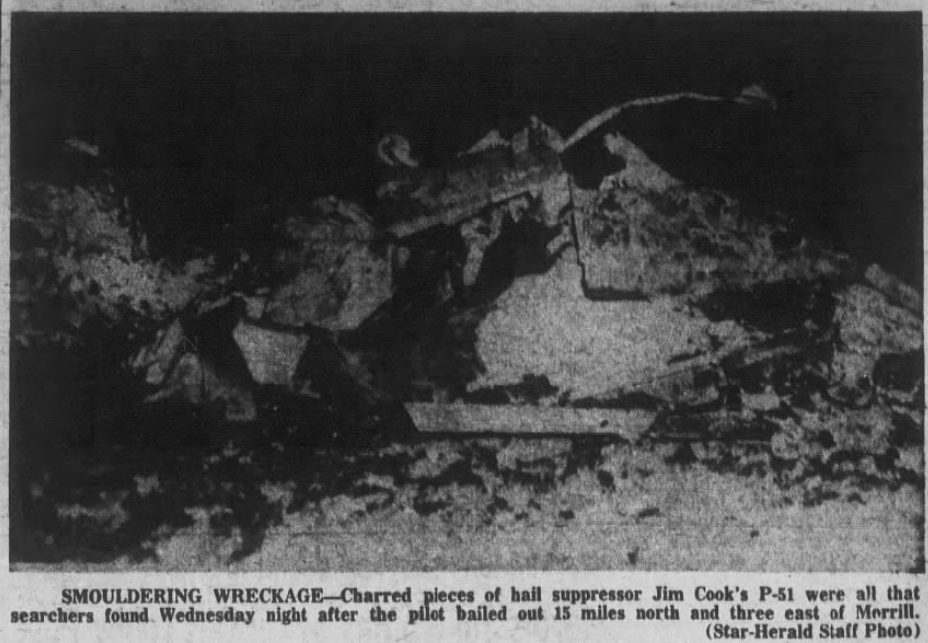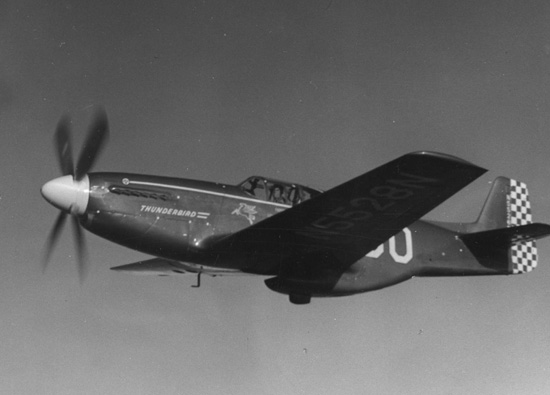
22 June 1955: A Bendix Trophy Race-winning ¹ and world record-setting ² North American Aviation P-51C Mustang, N5528N, which had previously owned by air racer Joe C. De Bona, actor and World War II bomber pilot, Jimmy Stewart, and world record-setter Jackie Cochran, was completely destroyed when it crashed approximately 15 miles (24 kilometers) north of Morrill, Nebraska, 22 June 1955.
N5528N, known both as Thunderbird and Mr. Alex, was being flown on a hail suppression operation by James M. Cook. After takeoff, one of the Mustang’s main landing gear failed to retract. When he was unable to resolve the problem, Cook flew the Mustang over unoccupied terrain north of Morrill, Nebraska, and bailed out.
The airplane crashed, exploded and the wreckage burned. N5528N was completely destroyed.
Cook survived with only slight injuries.
The Scottsbluff Star-Herald reported:
Hail Suppression Airplane Crashes North of Morrill
Pilot Cook Makes Successful Parachute Jump
By John Auran
(Star-Herald Staff Writer)
Hail suppressor Jim Cook Wednesday evening escaped death by a whisker when he was almost trapped in the plane he was trying to ditch. Cook took the plane down when one wheel locked in the up position and the other down. The plane crashed 15 miles north and three miles east of Morrill with Cook landing by parachute about a half mile south of the crash site. The daring hail suppressor fought a one hour and 40-minute battle in the air to get his landing gear straightened out, but failed in this despite radioed advice from several experts on the plane.
The fleet P-51 Mustang was smashed beyond recognition with only a few odds and ends remaining of what was once one of the fastest propeller driven planes in the world.
Cook escaped death in the following manner:
When he realized he could not safely crashland the plane he decided to take the plane north of Merrill to bail out.
First Trouble
His first trouble came when he tried to open the canopy which refused to function properly.
“I had to stand in the seat to push the canopy with my shoulders and it only partially opened, Finally by straining I pushed it off with my back.
“I sat down again to tell the airfield that I’d gotten the canopy off and caught one leg under me. As I rolled the plane I hung there and I couldn’t have been more that 700 feet off the ground when I finally got free. I started at about 3,000 feet.”
Cook said he trimmed the plane for the crash at about 3,000 feet and was unable to do anything further to prevent the plane from crashing.
“I tell you,” he said, “I was damn close when I left it.”
He said he saw the plane explode when he was still in the air. He estimated the plane hit the ground at a 30 degree angle.
Asked why he didn’t crashland the plane he said:
One Trotter Up
“I had one trotter (wheel) up and one down, about 100 gallons of gasoline in each wing and about 70 gallons behind me. In that situation it wasn’t worth risking my neck and those guys in the asbestos suits.
“I know those guys. They’ll go right in and there’s no point to that when the plane was going to be wrecked anyway.”
Cook said he left the field about 6:15. When he was airborne he became aware that the landing gears wouldn’t come up. He made several passes over the field to get ground men to determine the exact nature of his trouble.
When he first announced his intention to come down with the plane, fire engines from Scottsbluff rushed to the scene as spectators anxiously crowded the field to determine the outcome of the struggle.
Cook continued to make low passes over the field and from the ground until the nature of his trouble was learned.
When it was finally learned that he would bail out in the Morrill vicinity there was a rush to that vicinity by police, the Safety Patrol and interested parties.
A plane piloted by Earl Mean and Davey Guin, the latter an assistant of Cook’s, followed the plane to the crash site. However the two did not see the Texan bail out.
The crash was at 7:55 p.m.
As news of the crash spread through Morrill and vicinity hundreds of cars tried to find the plane and Cook.
At the crash scene little remained of the plane which once was the winner of the Bendix trophy and also held the record for propeller driven planes from Los Angeles to New York.
The ground was gouged out to a depth of up to six feet for a distance of at least 45 feet.
Because of darkness, there was no way to determine how far the wreckage was scattered but it was variously estimated at 50 to 100 yards.
Completely Demolished
Apparently the explosion completely demolished the plane. What was once the engine was unrecognizable as such.
Cook gave the description of the crash in his room at a Scottsbluff motel where he was taking a shower after the ordeal. The only injuries he suffered were deep scratches on his legs and a slight sprain.
Asked about the future of hail suppression in this area Cook shrugged his shoulders, saying “I’m not in a very good position to go much further.”
He said the fate of the program will be decided at a meeting of the board of directors of Valley Hail Suppression Inc. Friday.
The pilot said the plane was insured for $18,000, but pointed out that he had paid $28,000 for it and had spent another $7,000 in installing silver iodide burners for hail suppression purposes.
This was the third year of attempts at hail suppression by Cook in the North Platte valley. Only this year he had solved the tricky problem of high altitude burners and had hopes that the program might prove unquestionably worthwhile.
No Trouble
Cook said he took the plane up Tuesday when heavy thunderclouds hung over the valley and had no trouble with the plane. The first indication of trouble was when he was airborne Wednesday and he felt that his plane wasn’t gaining speed.
While he was a pilot in the Army Air Corps during World War II he had bailed out, but he did not want to go into details on the incident.
Asked about his immediate plans, he said, “I’m going to get dinner.”
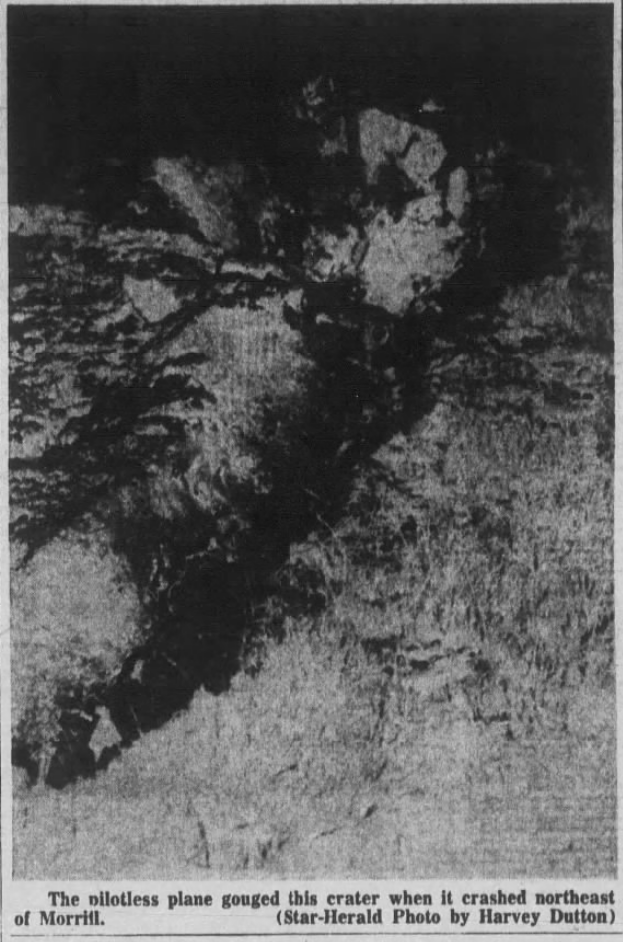 —Scottsbluff Star-Herald, Vol. 54, No. 308, Thursday, 23 June 1955, Page 1, Columns 6–8 and Page 3, Column 1
—Scottsbluff Star-Herald, Vol. 54, No. 308, Thursday, 23 June 1955, Page 1, Columns 6–8 and Page 3, Column 1
The earliest document in Thunderbird‘s Civil Aviation Administration file, Form ACA 132, contains the hand-written notation, “no service no.” The document states, “THIS AIRCRAFT WAS ASSEMBLED FROM COMPONENTS OF OTHER AIRCRAFT OF THE SAME TYPE.” The aircraft is designated on the form as a North American P-51C, Serial No. 2925.
Thunderbird, made up of salvaged parts, has no known Army Air Corps serial number. No North American Aviation contract number is listed in any document. It has no known history prior to the C.A.A. assigning it the civil registration NX5528N. The serial number 2925 does not conform to any U.S. Army Air Corps serial number sequence for P-51 series aircraft, nor does it conform to any N.A.A. contract number sequence for P-51s. It appears that this serial number was assigned to the P-51 by the Civil Aeronautics Administration.
Various sources attribute U.S.A.A.C. serial numbers to NX5528N, e.g., 43-6822 ³ and 43-6859. ⁴ There is nothing in the airplane’s C.A.A. records to substantiate these claims. The record specifically states that there is “no service no.” Some sources also describe Thunderbird as a P-51B or an F-6C photo reconnaissance variant. C.A.A. records specifically identify the airplane as a P-51C.
Thunderbird‘s fuselage was purchased as “salvage & scrap” from the 803rd A.A.F. Specialized Depot, Park Ridge, Illinois, by Allied Aircraft Co., Chicago, Illinois. The transaction is dated 14 January 194_ (the year was left blank on the contract). The purchase price was $27.05. Allied Aircraft Co. was a partnership of Leland H. Cameron and Martha L. Cameron, 5300 W. 63rd Street, Chicago, Illinois.
On 11 February 1948, Cameron purchased a P-51, Serial No. 2925, registration N5528N, from J. Quaine, for $1.00. On 5 April 1948, the Civil Aeronautics Authority (predecessor to the Federal Aviation Administration) registered N5528N to L.H. Cameron, 4619 Sancola Avenue, North Hollywood, California.
Two days later, 7 April 1948, Leland Cameron sold N5528N to Joe De Bona Racing Co., 133 N. Robertson Boulevard, Beverly Hills, California. The purchase price listed on the Department of Commerce Bill of Sale was $10.00. On that date, Joe De Bona applied to have the airplane registered in the name of his racing company.
Interestingly, on De Bona’s Department of Commerce Application for Registration, the serial number of N5528N is listed as “21925.” Information on the application is typewritten with the exception of this serial number, which was handwritten. As above, 21925 does not conform to any Army Air Corps or North American Aviation serial number for P-51B or P-51C Mustangs. This is the only instance in which 21925 appears in the airplane’s C.A.A. records.
On 31 August 1948, following an airworthiness inspection, C.A.A. Inspector Homer L. Stamets issued an original Airworthiness Certificate to NX5528N. The “Experimental” classification was used as there was no civil Type Certificate for North American’s P-51 fighters, and the C.A.A. had not tested or accepted the aircraft for any civilian use. The Experimental classification placed severe restrictions on De Bona’s use of Thunderbird. In the Operations Authorized section of the certificate it states, “Certificated for the purpose of Racing and Exhibition flights only; flights limited to the Continental limits of the UNITED STATES. Flights prohibited over thickly populated areas or large gatherings of people.” The certificate was valid for one year.
Noted on the Airworthiness Inspection form is that NX5528N was equipped with a Packard V-1650-3 engine. This license-built version of the Rolls-Royce Merlin 63 engine was standard equipment for early production P-51B and P-51C Mustangs. It was rated at 1,380 horsepower at 3,000 r.p.m. and 60 inches of manifold pressure.
The start of the 1948 Bendix Trophy Race took place on 4 September at Van Nuys, California. Joe De Bona was entered with Thunderbird, but was unable to complete the race. Reportedly low on fuel, he landed at Norwalk, Ohio.
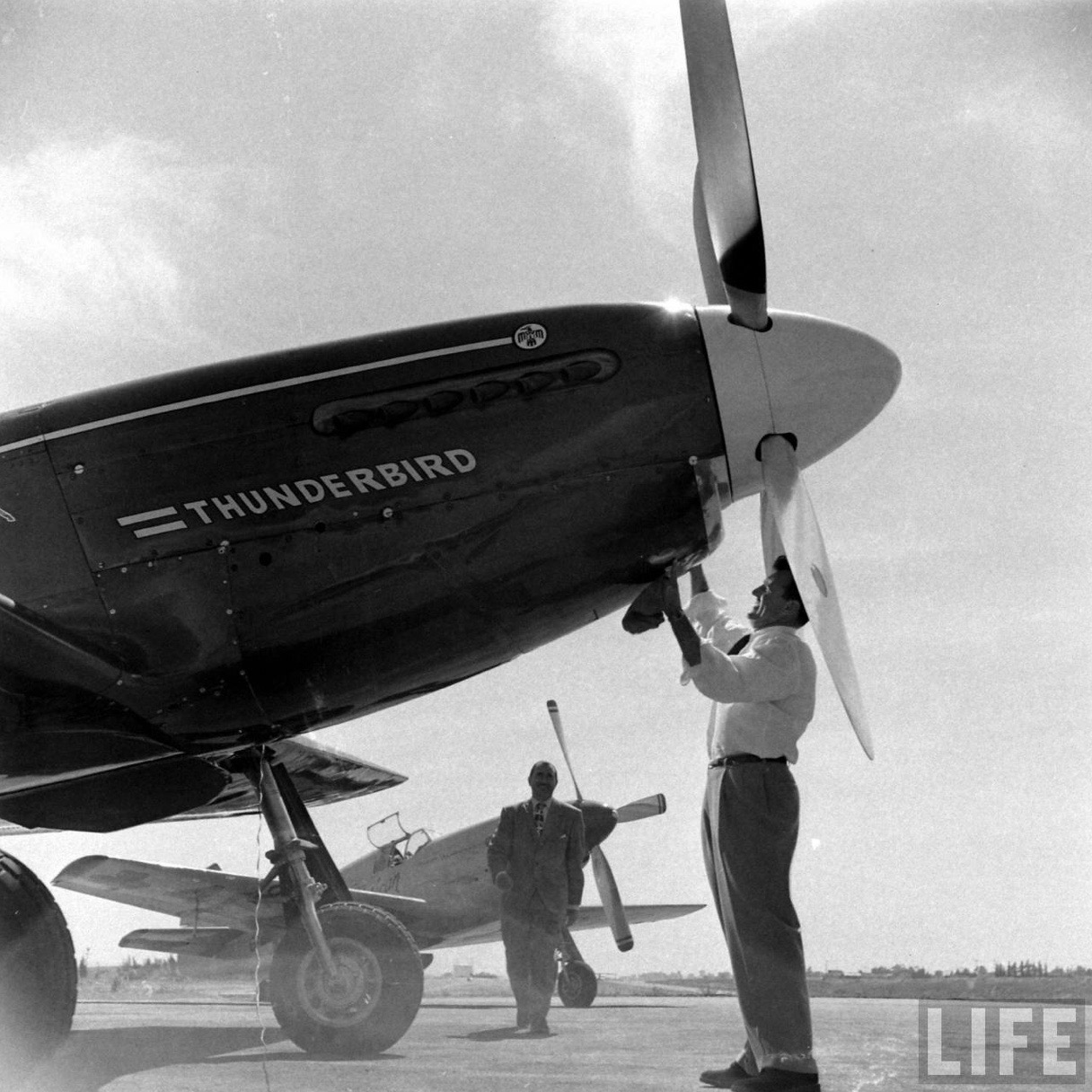
For 1949 Thunderbird‘s engine was upgraded to a Packard V-1650-7. C.A.A. Inspector Stamets again approved its airworthiness inspection and issued another one-year Experimental certificate with the same restrictions as previously ordered.
The start of the 1949 Bendix Trophy Race was relocated from Metropolitan Airport at Van Nuys to Rosamond Dry Lake, 40 miles (64.4 kilometers) north of Muroc Air Force Base (renamed Edwards AFB just two months later). This year Joe De Bona was successful. He won the 2,008 mile (3,231.6 kilometers) race to Cleveland, Ohio in an elapsed time of 4:16:17.5, averaging 470.136 miles per hour (756.611 kilometers per hour.) Paul Mantz did not fly in the race but entered two P-51Cs, flown by Stanley H. Reaver and Herman “Fish” Salmon, who placed 2nd and 3rd.
(Leland Cameron, who had sold N5528N to Joe De Bona Racing, also competed in the 1949 Bendix air race. He flew a Martin B-26C-20-MO Marauder medium bomber, serial number 41-35071, N5546N, but he did not finish within the prescribed time limit.)
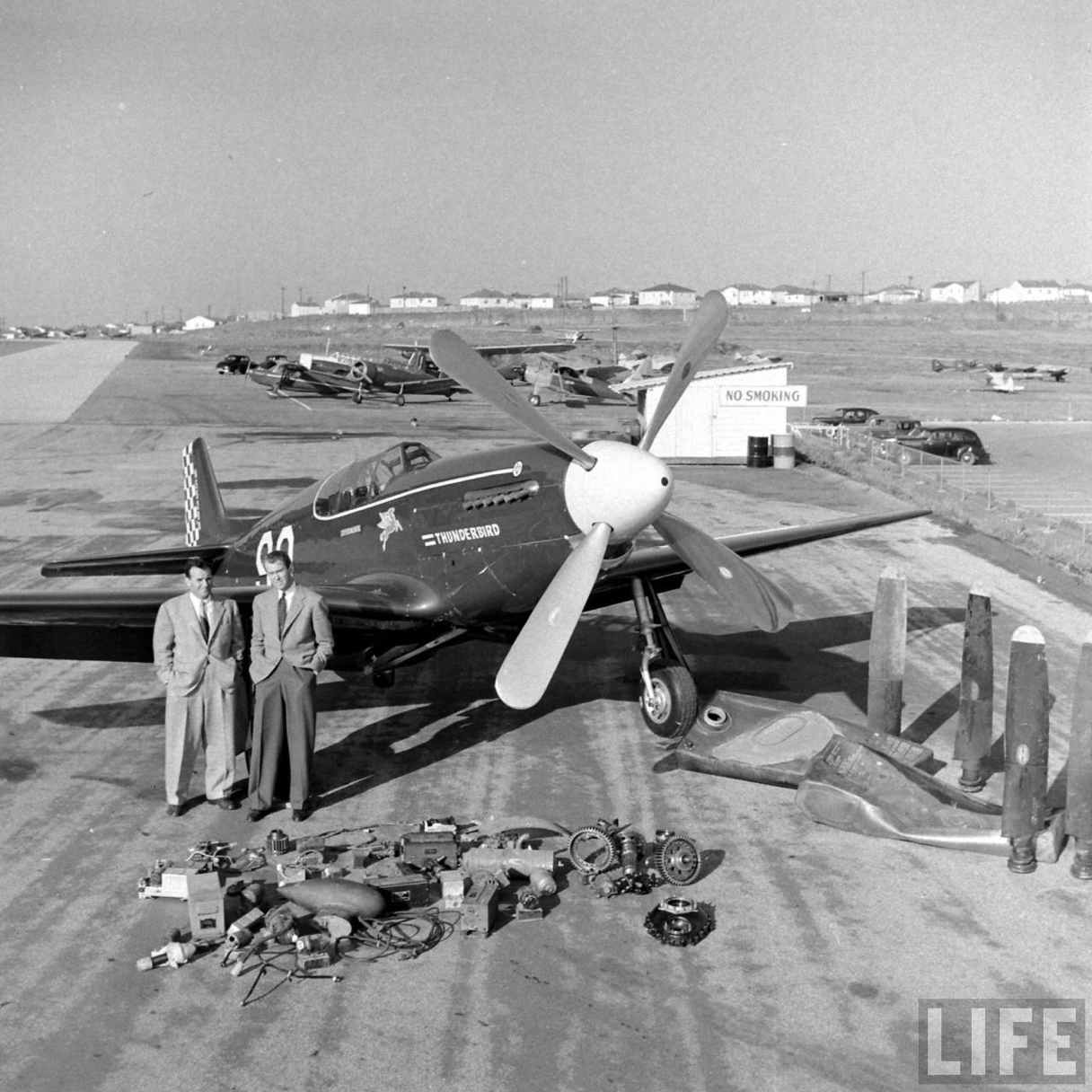
On 19 December 1949, James Stewart (Sole Owner, for Joe De Bona Racing Co.) sold N5528N to Jacqueline Cochran of Indio, California, for “$1.00 and other consideration.” The C.A.A. issued a new Certificate of Registration to Jackie on 29 December 1949.
That same day, Jackie Cochran flew her new airplane to two Fédération Aéronautique Internationale (FAI) World Records for Speed Over a 500 kilometer Closed Circuit Without Payload, and a U.S. National Aeronautic Association record, with an average speed of 703.275 kilometers per hour (436.995 miles per hour). (FAI Record File Numbers 4476, 12323)
Thunderbird underwent another airworthiness inspection, completed 10 November 1950 by Patrick J. Kavanaugh, A&E 402226. C.A.A. Inspector H.W. Kattleman issued a new Experimental airworthiness certificate, valid from 10 November 1950 to 10 November 1951. The limitations were identical to the restrictions described above.
Jackie set another Fédération Aéronautique Internationale record on 9 April 1951, flying NX5528N to an average speed of 747.338 kilometers per hour (464.374 miles per hour) over a straight 16 kilometer (9.942 miles) course at Indio, California. (FAI Record File Number 4477)
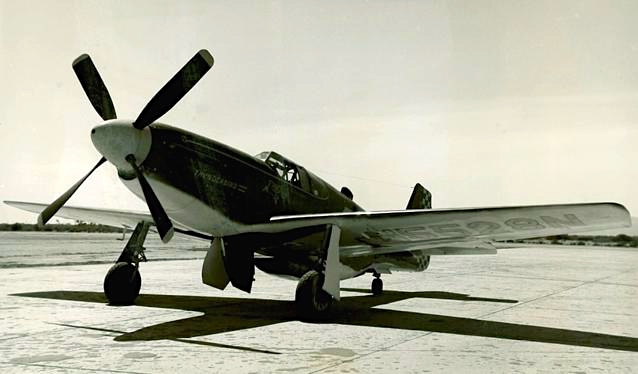
The next airworthiness inspection of N5528N was completed 26 March 1952 by mechanic James N. Smith. Once again, C.A.A. Inspector H.W. Kattleman issued an Experimental airworthiness certificate, valid from 31 March 1952 to 31 March 1953.
Jackie Cochran had owned Thunderbird for just over three years when, on 20 January 1953, she sold it back to Jimmy Stewart for “$1.00 and other consideration.” The C.A.A. registered N5528N to Stewart at 141 El Camino Drive, Beverly Hills, California, 9 April 1953.
Thunderbird received another engine upgrade, this time to a Packard V-1650-9, serial number V381230. (This engine was rated at 1,380 horsepower at 3,000 r.p.m., but could produce a maximum 2,280 horsepower with water-alcohol injection.) The next airworthiness inspection was completed 31 March 1953 by a mechanic with certificate number M-17807. At the time of this inspection, N5528N had accumulated 76:00 hours total flight time (TTAF). The V-1650-9 engine had only 14:10 hours since new. C.A.A. Aviation Safety Agent Ralph C. Olsen approved the next airworthiness certificate.
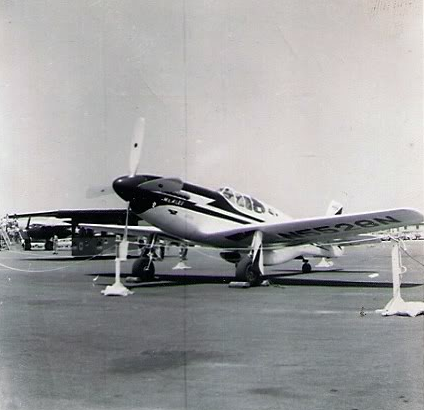
At about this time, N5528N was repainted and renamed Mr. Alex in honor of Jimmy Stewart’s father, Alexander Maitland Stewart.
A major event of 1953 was the Coronation of Elizabeth II on 2 June. American television networks CBS and NBC had arranged to have films of the ceremonies flown across the Atlantic to Newfoundland. From there the film would be flown on to the United States by Jimmy Stewart’s P-51 and another owned by Paul Mantz, NX1204, flown by Stanley Reaver.
Jimmy Stewart asked the C.A.A. to temporarily remove the limitations on NX5528N’s airworthiness certificate so that it could be flown out of the United States to pick up the films at Newfoundland and return with them to Boston, Massachusetts. C.A.A. Aviation Safety Agent Ralph C. Olsen approved this request. A second flight to Montreal, Canada, was also authorized. The restrictions would resume when the Experimental category Mustang returned to the United States after the Montreal trip.
Joe De Bona was once again in the cockpit of N5528N. He arrived at Boston 24 minutes before his rival, Stan Reaver, but a third network, ABC, was actually the first to broadcast the films of the Coronation.
On 30 March 1954, another airworthiness inspection was completed by the same mechanic as the 1953 periodic inspection. Once again, the airworthiness certificate was approved by Ralph Olsen. Total flight time for N5528N was now 118:00 hours, with 42:50 on the Merlin engine.
On 1 September 1954, Jimmy Stewart sold N5528N to Joe De Bona for $1.00 plus a $7,500.00 Chattel Mortgage. On 14 March 1954, the C.A.A. registered the airplane, which they now designated as a North American F-51C, to De Bona at 339 North Beverly Drive, Beverly Hills, California.
An airworthiness inspection was completed 17 March 1955. The mechanic performing the inspection held certificate number M7427. The V-1650-9 had been removed and replaced with a Packard V-1650-300, serial number V350012. This post-war commercial engine was rated at 1,660 horsepower at 3,000 r.p.m. The airframe now had 150:00 hours TTAF, and the new engine had 30:00 hours.
The following day, 18 March 1955, Joe De Bona sold N5528N to James M. Cook of Jacksboro, Texas, for $18,000 plus a $7,000 Chattel Mortgage at 4% interest, payable on or before 1 January 1956. The C.A.A. issued a Certificate of Registration to Cook on 31 March 1955.
On 22 June 1955, North American Aviation P-51C Mustang NX5528N crashed near Scott’s Bluff, Nebraska, while being flown by James Cook. Although an official cause is not available, anecdotally, one of the P-51’s main landing gear failed to retract and Cook bailed out. Although an accident report was completed 13 July 1955, the Federal Aviation Administration currently has no report in its files, nor does the National Transportation Safety Board. The Mustang was deregistered 15 August 1955. (James Cook soon bought another Mustang, P-51D N71L, which he flew for several years as part of the U.S. Weather Bureau’s Thunderstorm Research Airplane Project.)
Warren A. Piestch of Pietsch Aircraft Restoration and Repair, Inc., Minot, North Dakota, purchased a tail wheel assembly and other parts from a wrecked P-51 located in Nebraska, 23 June 1999. He wrote to the F.A.A. and stated that these parts were from P-51 serial number 2925, and that he wanted to rebuild the aircraft. Pietsch requested that ownership of 2925 be assigned to him and that a registration N-number that he had previously reserved, N151LP, be assigned to the airplane. The F.A.A. did as Pietsch requested. That registration was valid until 30 April 2015. On 24 September 2007, 2925 was registered to Pietsch with its original “N number” of N5528N. That registration remains in effect. There is no current Airworthiness Certificate.
AirCorps Aviation of Bemidji, Minnesota, has “restored” a P-51 for the Dakota Territory Air Museum, which they identify as the record-breaking Mustang, Thunderbird. (Warren Pietsch is a member of the museum’s board of directors.)
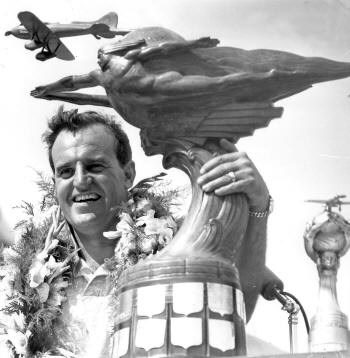
¹ Flown by Joe C. De Bona, NX5528N won the 1949 Bendix Trophy Race, 3 September 1949, with an average speed of 470.136 miles per hour (756.611 kilometers per hour), on 3 September 1949.
² Jacqueline (“Jackie”) Cochran flew NX5528N to set two Fédération Aéronautique Internationale world speed records and a U.S. National record on 19 December 1949. She averaged 703.275 kilometers per hour (436.995 miles per hour) over a 500 kilometer closed circuit. (FAI Record File Numbers 4476, and 2323) On 9 April 1951, she set a third FAI record with Thunderbird, with an average speed of 747.338 kilometers per hour (464.374 miles per hour) over a straight 16-mile course. (FAI Record File Number 4477)
³ 43-6822 was a P-51B-5 which crash landed at Staplethurst, Kent, England, 28 April 1944.
⁴ 43-6859 was also a P-51B-5. It crashed at Megara, Greece, 15 September 1944. Its pilot was killed.
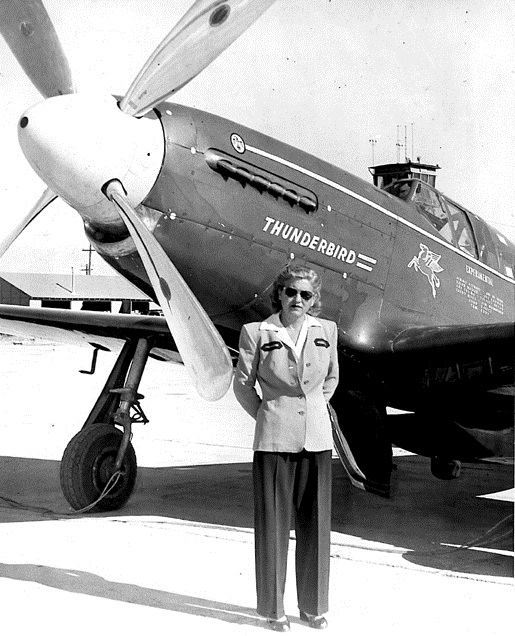
© 2023, Bryan R. Swopes
